I was struggling with how to determine the outer foil on some caps and after trying a number of different techniques such as squeezing the cap, placing over a piece of energized lamp cord (120V 60Hz) and an article in this months Nuts and Volts magazine without clear cut results, I tried something else.
Wrapping a length of soft wire around the cap, hooking my oscilloscope to that wire and sending a 10 kHz signal through the cap and observing the sine wave was pretty enlightening when the signal generator leads were switched. Wrapping three to four times around the cap led to unambiguous results except for the blue/green rectangular Kemet which did show a very small difference.
See pictures for some of the results.
Obliggato 0.47uf
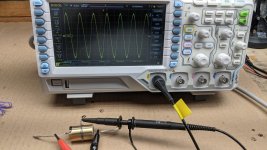

Mundorf 1.0uf

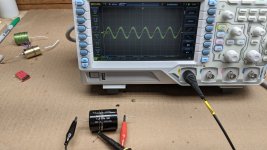
Panasonic 0.033uf (I think)
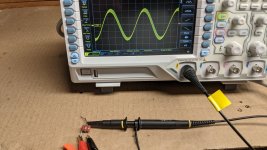
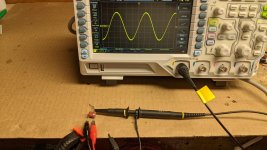
Wima 0.022uf
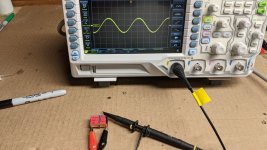
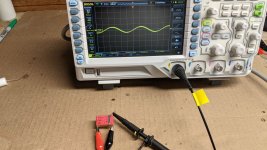
CDE 1.0uf
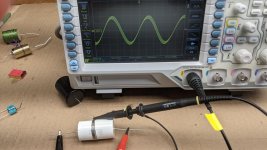
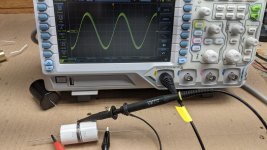
Miflex 0.1uf (Outer foil marked by black line)
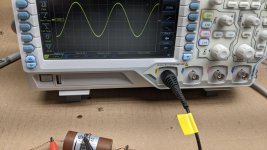
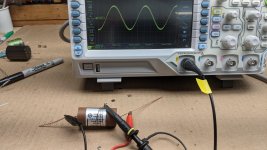
Kemet 0.033uf (no significant difference)
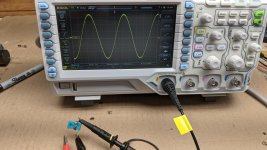
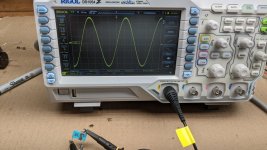
Thoughts or criticisms welcome.
Wrapping a length of soft wire around the cap, hooking my oscilloscope to that wire and sending a 10 kHz signal through the cap and observing the sine wave was pretty enlightening when the signal generator leads were switched. Wrapping three to four times around the cap led to unambiguous results except for the blue/green rectangular Kemet which did show a very small difference.
See pictures for some of the results.
Obliggato 0.47uf


Mundorf 1.0uf


Panasonic 0.033uf (I think)


Wima 0.022uf


CDE 1.0uf


Miflex 0.1uf (Outer foil marked by black line)


Kemet 0.033uf (no significant difference)


Thoughts or criticisms welcome.
I watched that a few times but his squeeze technique was unsuccessful for me and the contraption he built was far to complicated for me. I'm a novice builder who barely knows which end of the soldering iron to grab.Mister Carlson's Lab (May 2015) YouTube link
What do you think if the results I obtained without building something over my head?
You should use a more substantial tin foil, make the measurement on a ground plane and take great care to minimize the direct interaction between the "hot" side and the oscilloscope probe: you measure the interaction of 1 or 2pF with the scope, and any parasitic will ruin the measurement.
More here: https://www.diyaudio.com/community/...rement-with-hantek-6022be.324126/post-5468368
This is probably too complicated for you, but it does the business automatically, by itself and deterministically, without the guesswork: https://www.diyaudio.com/community/...oil-tester-for-capacitors.347062/post-6019252
And it doesn't cost an arm and a leg.
Note that some capacitors have a ~symetrical construction, and will show no difference, whatever the method
More here: https://www.diyaudio.com/community/...rement-with-hantek-6022be.324126/post-5468368
This is probably too complicated for you, but it does the business automatically, by itself and deterministically, without the guesswork: https://www.diyaudio.com/community/...oil-tester-for-capacitors.347062/post-6019252
And it doesn't cost an arm and a leg.
Note that some capacitors have a ~symetrical construction, and will show no difference, whatever the method
I have found a number of mismarked capacitors (I don't remember the percentage exactly, but it was surprisingly high) thus correlation is just an indicator, not a rock-solid proof
Informal statistics on a much larger sample size showed something like 12% incorrectly marked for those that were clearly marked.
Frome here: https://www.diyaudio.com/community/...oil-tester-for-capacitors.347062/post-6860700
I would just wrap the cap with sticky backed foil and measure the capacitance from the foil to each lead.
It wouldn't work without grounding one lead and driving the other with the test signal: the capacitance of the DUT is much larger than the pF or two of the foil.
Problem: most ordinary capmeters are 2-wire, not kelvin, and even then measuring a pF whilst driving a 1µF would be challenging for reasonably-priced meters
Problem: most ordinary capmeters are 2-wire, not kelvin, and even then measuring a pF whilst driving a 1µF would be challenging for reasonably-priced meters
I did find one of the four caps I have that have with the outer foil mis-marked if my measurements are to be believed. The cap in question is a Miflex (yup, a boutique cap) 1.5uf. It measures very similar in terms of actual PP voltage to my other one of the same type, just the markings don't agree. I think I will believe my measurements when I install them.
Any suggestions as to other caps with outer foil markings I could purchase for testing?

Any suggestions as to other caps with outer foil markings I could purchase for testing?
- Home
- Design & Build
- Equipment & Tools
- Critique my Outer Foil Determination Process